Revolutionary development of the firing technique of the English fleet at the turn of XIX–XX
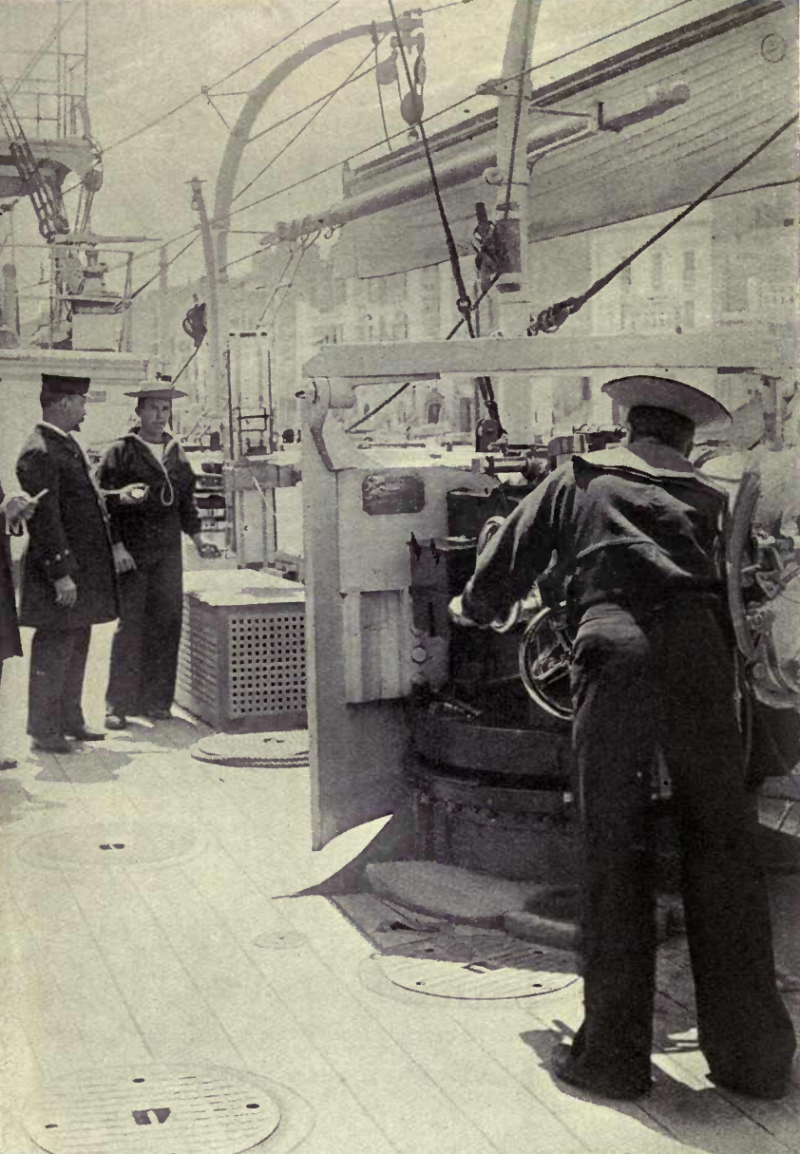
Shooting from naval guns at the end of XIX
In the second half of the 1890th century, naval artillery experienced a period of rapid development. In the XNUMXs, the leading maritime powers were already armed with powerful and accurate guns that, in theory, could successfully hit targets at a distance of several kilometers. However, in practice, effective shooting at sea was hampered by two unresolved issues.
Distance is the first question. The existing goniometers did not have the necessary accuracy and, moreover, could not be used in all conditions. A more accurate way to determine the distance was sighting. But then a second unresolved issue arose, which prevented both shooting and shooting to kill - shooting on the roll.
The gunner needed to catch the moment when the line of sight coincides with the target, and fire a shot. An error of 0,1 seconds could cause the projectile to pass 10 meters above or below a target at a distance of 1 km. Considering that the reaction time of a person ranged from 0,4 to 0,8 seconds and was not constant, the ability to shoot accurately was considered to be navy the highest skill, and shooting at a distance of more than 1 km - empty throwing of shells.
In the English Navy, the attitude towards artillery had its own specifics. At the end of the XNUMXth century, purity and brilliance became almost an object of worship. For the commander, the highest achievement was the best polish of his ship for the parade on the Spithead roadstead.
Shooting from cannons was perceived as the worst enemy of beauty and order on the ship: after it, cleaning, cleaning, painting and even minor repairs were inevitably required. Artillery exercises were carried out purely formally, and no one was interested in how many shells hit the target. A more important occupation for artillery officers was considered to be polishing their household.
Percy Scott - Pioneer in Naval Artillery
The situation suddenly changed in 1898–1899. thanks to two events.
First, there was the Battle of Santiago between the American and Spanish squadrons, in which the low skills of the Spanish gunners became one of the main reasons for the defeat.
Secondly, the outstanding results of the prize firing of the 120-mm guns of the modest 2nd class cruiser Scylla under the command of Percy Scott became known: 80% even in the presence of a slight swell. Whereas the average for the fleet was only 31,1% of hits.
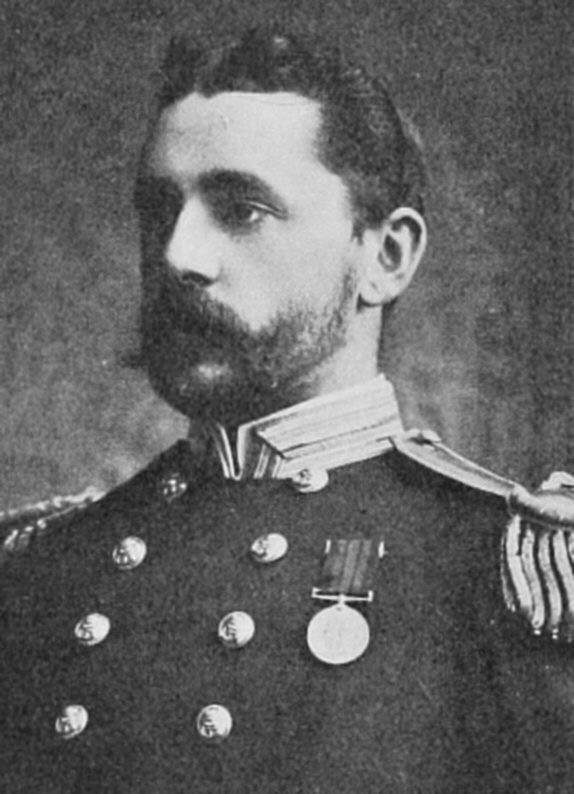
Percy Scott
The British Admiralty paid attention to the level of training of gunners, and from 1899 began to allocate large sums for the prize fund to the gunners who showed the best results in prize shooting. Firing results reports were now published annually. All England knew the best squadrons, the best ships and the best gunners. Excellent results in shooting have now become the basis for an extraordinary promotion.
The secret of Percy Scott's achievements was the use of innovation, both in shooting itself and in the process of training. To improve the accuracy of pointing, he introduced optical sights of his own design. For more accurate shooting in rough conditions - a method of continuous aiming, involving the constant presence of the target in the sight. To train gunners, Percy Scott invented a dotter, a special simulator that simulates shooting, taking into account the excitement and movement of the target. For frequent training without the use of expensive shots, barrels were used - rifles fixed in the barrel of guns. Regular shooting developed the skills of accurate and fast shooting among the gunners.
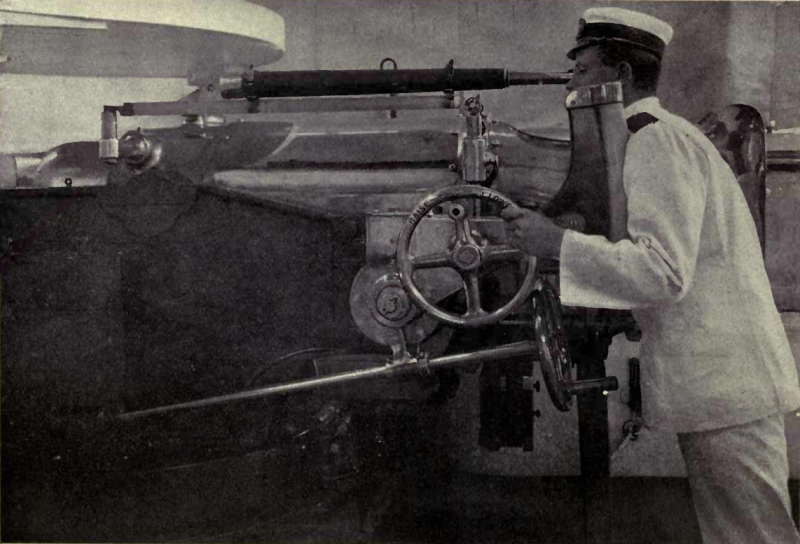
Optical sight designed by Percy Scott
In 1899, Percy Scott was appointed commander of the newest 1st class cruiser Terrible, which went to China. He successfully applied the progressive innovations tested on the Scylla on the new ship. At the 1900 prize shooting, after only a week of dotter training, the Terrible was 77% accurate, while the rest of the fleet was only 32,3%.
Percy Scott was constantly thinking about new improvements. To speed up the rate of fire, he came up with a machine for training loaders, repeating the design of the gun.
Percy Scott created a "preemption simulator" - an improved dotter. The training was carried out on the shore and gave the plutong commander practice in issuing orders to change the pickup, and the gunner - the skills to follow orders, simulating fire adjustments to observe the fall of shells.
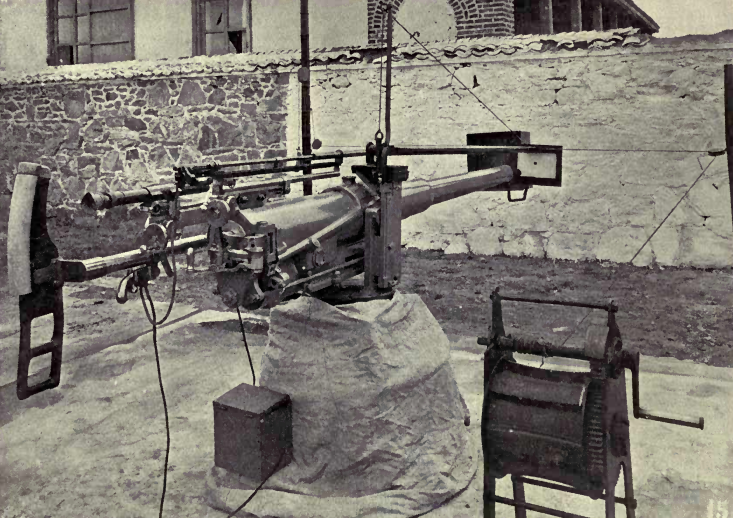
lead simulator
Percy Scott upgraded the practice shield to withstand a large number of hits.
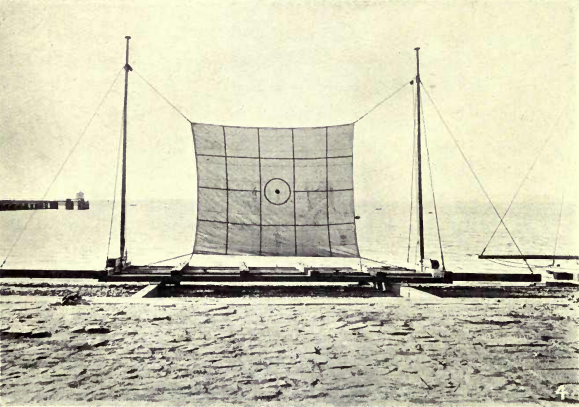
Training shield designed by Percy Scott
The commander-in-chief of the Chinese squadron, Admiral Edward Seymour, noted the successes of Percy Scott and introduced his methodology throughout his squadron.
The Admiralty was also interested in the progress and received recommendations from Percy Scott to improve the accuracy of the shooting. However, instead of accepting these recommendations throughout the fleet, they were sent for consideration to the artillery school to one of the junior officers ...
In 1901, Terrible demonstrated an accuracy of 80% in prize shooting. This achievement was noted throughout the English press. Percy Scott became famous all over the country.
At the same time, one of Percy Scott's students on the battleship Barfleur achieved an accuracy of 72% and thus proved the possibility of successfully introducing innovations on other ships.
The Admiralty again wrote to Percy Scott asking him to detail his methods for implementing them throughout the fleet. Percy Scott sent a lengthy response, but also noted that his previous recommendations were being ignored.
In 1902, the Terrible solemnly returned to England. Taking the opportunity, Percy Scott at the reception of King Edward VII read out a list of complaints:
1. Lack of attention to artillery on the part of the Admiralty Council.
2. Gloss on the ship influenced promotion much more than achievements in shooting.
3. Insufficient amount of artillery fire.
4. Inefficiency of existing sights.
5. The need to develop a competitive spirit in shooting.
6. The Admiralty hid the results of unsuccessful firing.
At the meeting of the House of Lords, the First Lord of the Admiralty, William Selborne, assured those present:
However, in practice, the admiralty actually sabotaged the introduction of innovations.
In 1903, Percy Scott took over England's largest artillery school at Portsmouth, where he introduced his training methods.
Long range shooting
Percy Scott's technique worked well at prize shooting distances of about 1 yards (500 m), when the gunner could clearly see the fall of his shells. However, at long distances, especially in foggy weather, the falling shells were not visible.
The issue of organizing firing at long distances was raised by officers of the Mediterranean Squadron, which, under the command of John Fisher, in 1899-1900. conducted shooting at a distance of 5 ... 000 yards (6 ... 000 m). The officers came to the conclusion that it was necessary to fire in volleys in order to clearly observe its results. In practice, firing in volleys turned out to be difficult for a number of reasons, ranging from the lack of effective means of communication for coordinating the moment of the shot to the large spread of shells fired from different guns.
The theory of long-range shooting was developed by Edward Hariding, one of the officers who participated in the firing of the Mediterranean fleet. He proposed the use of centralized fire control, that is, the firing of all guns according to uniform aiming parameters calculated in the conning tower.
The issue of a large spread of shells fired with the same aiming in one salvo was decided by Percy Scott. He did an experiment. Several guns were placed on the shore, pointed at one target and fired shots. The large spread has been preserved. Its cause was not pitching, as many officers thought, but the imperfection of gun sights!
Percy Scott asked the Admiralty to immediately replace sights in the entire fleet with more advanced ones, and this was done in 1905-1907.
In the spring of 1904, the Admiralty tested Edward Hariding's technique on firing practice for two ships at once: the Victories in the Canal squadron and the Venerable in the Mediterranean squadron. The 12-inch guns of the battleships could not use continuous aiming, since the existing mechanisms did not provide the necessary angular velocity along the vertical. I had to fire a shot at the moment the ship was at the top of the wave.
Based on the test results, it was concluded that at distances of more than 4 yards (000 m), firing from 3-inch guns is more effective than from 658-inch.
Firstly, 12-inch guns were more accurate, and secondly, at a high rate of fire, numerous bursts from 6-inch shells impede observation of the target. The maximum possible effective firing range was determined at 8 yards (000 m).
Further, taking into account the experience of the battle in the Yellow Sea in 1904, it was decided to create a new generation battleship, armed only with main caliber artillery - the Dreadnought.
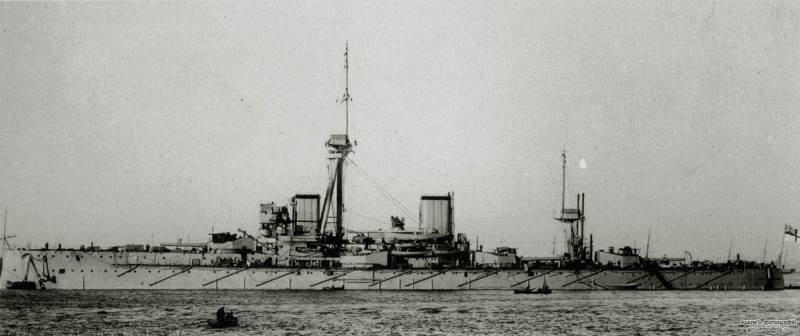
Battleship Dreadnought
Implementation of the Percy Scott technique throughout the fleet and live firing 1905
It wasn't until John Fisher became First Lord of the Admiralty in 1904 that progressive gunnery training was introduced throughout the English navy. Percy Scott in 1905 was appointed to the specially created position of Inspector of Naval Ordnance. He was present at all the shootings of the fleet, reported on their results, and made suggestions for improvements. On ships that showed poor results, he conducted analyzes of the reasons for inadequate training.
Big changes in the rules for competitive shooting occurred in 1905: it was decided to shift the focus from prize shooting to live firing of ships. These changes were due to various reasons.
Firstly, the experience of the Russo-Japanese War demonstrated the importance of centralized control of artillery fire, and prize shooting honed only individual skills.
Secondly, earlier combat firing was not carried out according to a single methodology, respectively, it was impossible to compare their results.
Since 1905, Barr and Strouda rangefinders were used to determine the distance in live firing, the observation of falling shells was carried out from Mars, fire control was carried out centrally from the conning tower using electromechanical transmitters.
The target was a 30 x 90 foot (9,1 x 27,4 m) shield placed on a floating raft. The fire was fired at a speed of 15 knots from a distance of 6 yards (000 m) for 5 minutes.
In 1905, a unified methodology for assessing the accuracy of shooting was adopted. The result depended on the number of hits in the allotted time. Each hit achieved by a 12-inch projectile was multiplied by 134, and by a smaller caliber projectile by 82. Then the resulting amount was divided by the number of guns that took part in the shooting. According to the number of conditional points scored, it was possible to compare different ships.
The press published a diagram of hits on the shield by shells fired during the exercises by the battleship King Edward VII:
12-inch guns achieved 10 hits out of 11 shots (91%);
9,2-inch guns scored 15 hits out of 31 shots (48%);
6-inch guns scored 26 hits out of 71 shots (37%).
Total: 51 hits out of 113 shots (45%).
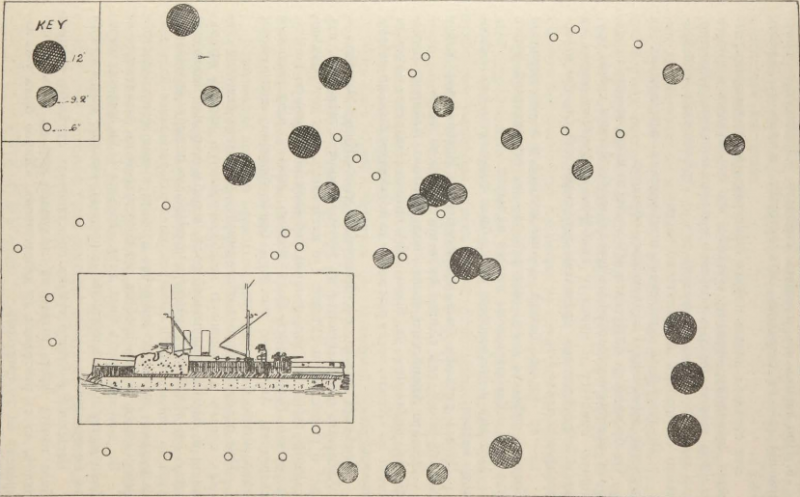
The scheme of hits in the shield shells "King Edward VII"
The best firing result in 1905 was shown by the flagship of the Exmouth Canal Squadron:
12-inch guns achieved 15 hits out of 16 shots (94%);
6-inch guns scored 49 hits out of 96 shots (51%).
Total: 64 hits out of 112 shots (57%).
However, Percy Scott was disappointed with the results of combat shooting in 1905, since, along with outstanding results, mediocre and even frankly disastrous results were demonstrated.
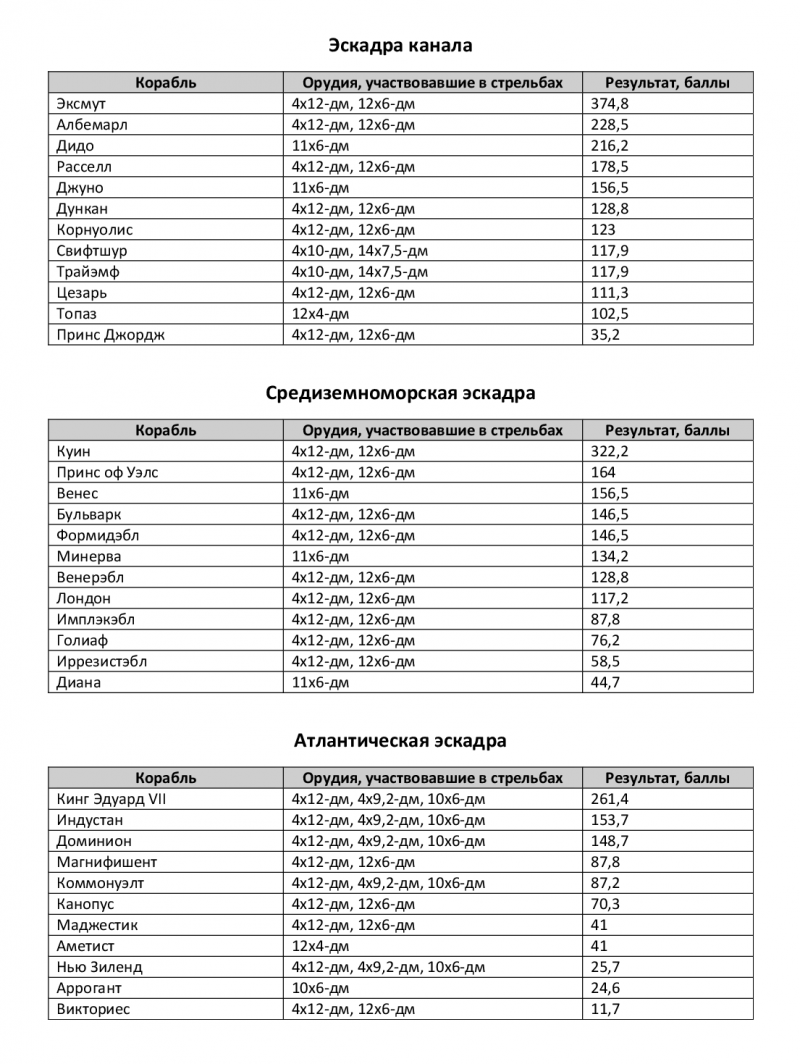
The results of combat firing in 1905
Commander training
In order to attract the most talented sailors to the artillery, the Admiralty decided to use additional incentives.
In 1905, special ranks were introduced for the lower ranks with special distinguishing marks and increased salaries:
• tower gunner,
• battery gunner,
• turret sight installer,
• battery gun sight installer,
• sailor gunner.
Applicants for new ranks had to take artillery courses and show satisfactory shooting results. There were so many who wanted to become a gunnery that strict entrance competitions had to be introduced. Not only the presence of physical disabilities or negative misdeeds in the past, but even a sloppy packed suitcase could serve as an obstacle to admission to artillery courses.
Training was conducted at naval artillery schools, the largest of which was located in Portsmouth and was designed for 150 officers and 1 sailors annually.
Competent sailors at least 21 years old, who had already served in the Navy for more than two years, were accepted for the courses of gunners. Before school, they had to complete a basic 25-day artillery course on their ships, which included training on a dotter, barrel shooting, and six live shots from 47-mm or 57-mm guns.
For training, old ships were used, on which modern small and medium-caliber rapid-fire guns, optical sights and fire control devices were installed.
Commander - the basic rank in artillery, who received it had to be able to perform all duties at the gun. For the replacement of the missing gunner, the gunner was entitled to an increase in salary.
To obtain the rank of gunner, it was required to complete a 50-day course.
pupils primarily studied the design of the gun, the mechanisms for feeding shells, the rules for caring for equipment. They developed the ability to quickly load the gun and maintain the pace for a long time.
The shooting course began with exercises on the dotter. The student developed the skills to hit the target at different speeds of its movement and the pitching of the ship.

Dotter training
The second stage - 50 shots with bullets from barrels at anchor from a short distance at a moving and swinging target. The future gunnery learned to correct hits, inform the sight installer of the correction: so much higher or lower, so much to the left or right.
The third stage - barrel firing from a 120-mm gunboat gun on the move along a steel bar from a distance of good visibility, that is, no more than 1,5 cables (278 m). Hitting a bullet in a rod is clearly audible. The student developed the skills to independently adjust the sight and rear sight when changing the heading angle to the target.
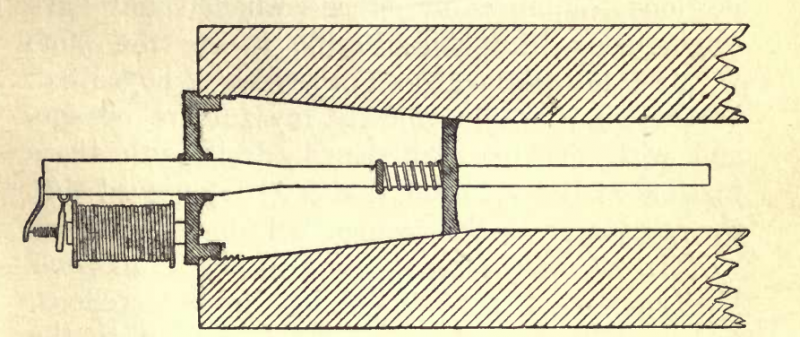
Scheme of installing a rifle in a gun barrel
The fourth stage - firing two series of 5 shots from a 120-mm gunboat gun at anchor at a shield measuring 6x8 feet (1,8x2,4 m) from a distance of 7 cables (1 m). The student mastered the observation of the flight of the projectile and the assessment of the magnitude of undershoot or overshoot.
Fifth stage - 10 shots from a 120-mm or 152-mm gunboat gun on the move at a speed of 12 knots against a shield 6x8 feet (1,8x2,4 m). The future gunnery learned to adjust the aiming according to the results of the falling shells.
If for some reason the gunnery did not practice shooting for three years, then he had to take a special course to restore his skills. Otherwise, he would lose his title.
The student who excelled in the gunner's course usually received an invitation to take the gunner's course.
The gunner's course repeated the same stages of shooting training as the gunner's course, but with significant differences. Firstly, a significantly larger number of shots were allotted for practice. Secondly, the training was carried out on a cruiser that had 152-mm guns, and not on a gunboat.
The best students received the title of gunner of battery guns, the rest, who successfully completed the course, received the title of installer of the sight of battery guns.
Gunners of battery guns, who showed excellent shooting results, were invited to the next course - gunners of turret guns, which differed significantly from the rest of the courses.
The first stage of training took place on the shore in a 12-inch tower, which was the same in design as on the battleships of the Formidable type. Shooting was carried out with rifle cartridges from barrels at swinging and moving shields.
Further, a similar exercise was performed on the Rivenge training battleship on the move from a 12-pounder (76-mm) gun mounted on the roof of the tower and having the same elevation angle as the tower guns. The gunner had to fire 30 shots from a distance of 3 cables (556 m).
The course ended with firing on the move from 13,5-inch guns at the shield from a distance of 8 ... 10 cables (1 ... 482 m).
In parallel, classes were held to study the design, operation and maintenance of guns, turrets and ammunition supply systems, including hydraulic equipment.
The effect of the introduction of new techniques in artillery
The introduction of new artillery techniques throughout the British Navy had a tremendous effect. The average accuracy of shooting at prize shooting in 1906 increased by more than one and a half times compared to the results of 1904!
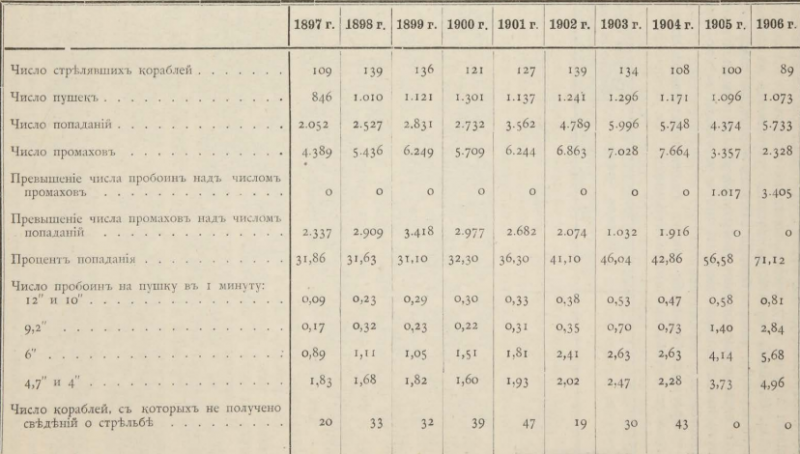
Comparative result of prize firing of the English fleet
The ability of British naval gunners to shoot quickly and accurately became an important argument that the mistress of the seas could present in defense of her status.
Information